#mens headwear
Note
Hi! I keep seeing hanfu robes with just one shoulder, usually for men. What's up with that? Is it a thing that actually existed?
Hi, thanks for the question, and sorry for taking ages to reply!
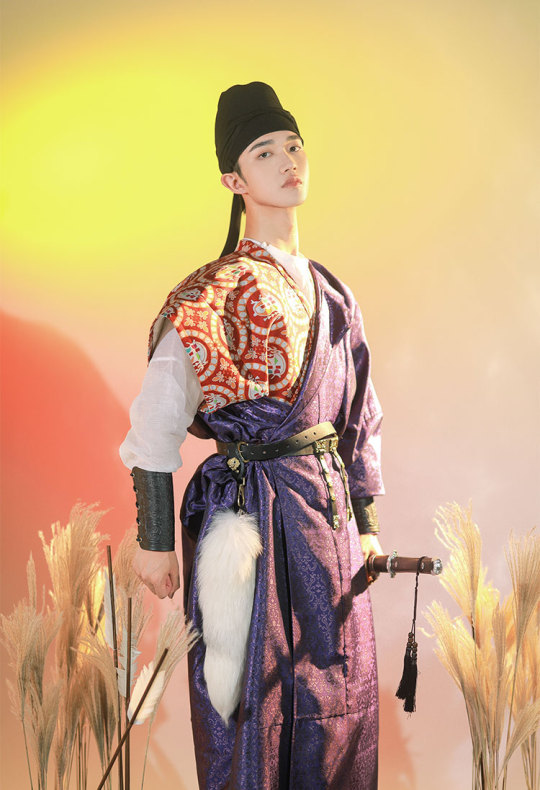
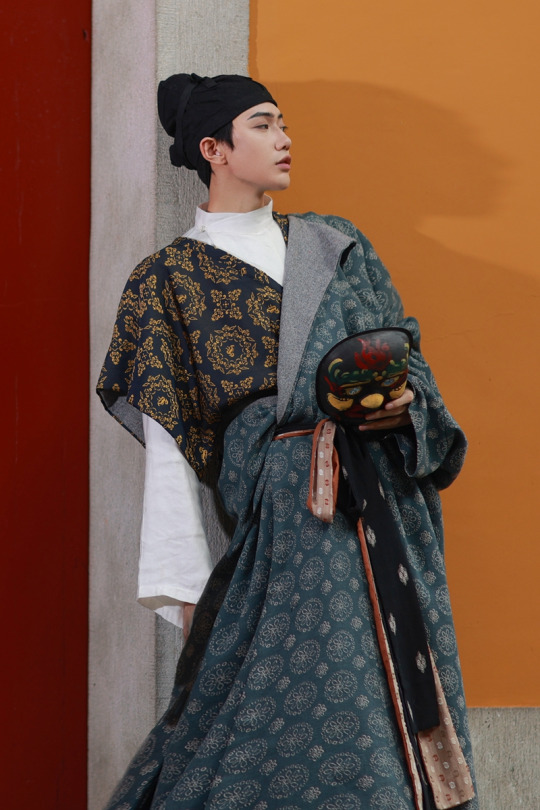
Yes, the style of wearing hanfu robes with just one shoulder for men existed historically, during the Tang dynasty. As @beehunni62 wrote in this post:
The specific trend of hanfu worn here was one used during the Tang Dynasty, specifically for archery and/or horse riding. It’s composed of a white silk round collar undershirt 圆领汗衫中衣, a jacket called a banbi 半臂, and a round collar robe 圓領袍.
The sleeve pertaining to the arm of the dominant hand was removed from the shoulder and tucked under the belt to allow for maximum mobility and comfort while shooting arrows or horse riding.
The trend created the opportunity for two or more different fabrics to be placed side by side showcasing an aesthetic contrast.
Please check out the post for a more detailed explanation with images.
Hope this helps! ^^
(Tang dynasty-style men’s hanfu photos via 君陈 and 汀兰颂)
#hanfu#mens hanfu#tang dynasty#zhongyi#banbi#yuanlingpao#history#reference#ask#reply#futou#mens headwear#>500#china#君陈#汀兰颂#chinese fashion#chinese clothing#chinese culture
691 notes
·
View notes
Text

#photography#aesthetic#beautiful#lifestyle#mens style#handsome#travel#portrait#culture#turban#middle east#headwear
132 notes
·
View notes
Text
Photos of 16th-17th century Irish clothing
Extant garments in the National Museum of Ireland
Notes: The garments in this post are all bog finds which means their current color may not be their original color. Although some of these items were found with human remains, no photos of human remains are included in this post.
Killery Cóta Mór (great coat) and brogues:
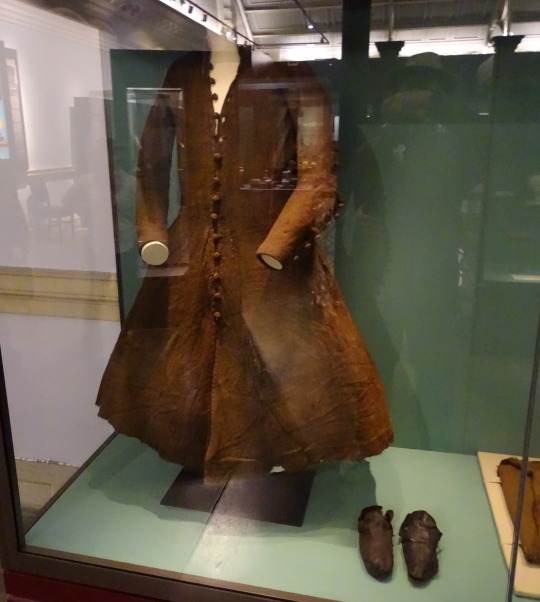
photos by hayling billy used under non-commercial, share alike license
The Killery outfit comes from an adult male bog body found in Killerry parish, Co. Sligo in 1824. It includes a cóta mór, triús, a brat, and shoes which are on display in the museum, and a sheepskin biorraid (conical hat) which fell apart shortly after it was found (Briggs and Turner 1986).
Killery triús (trews):
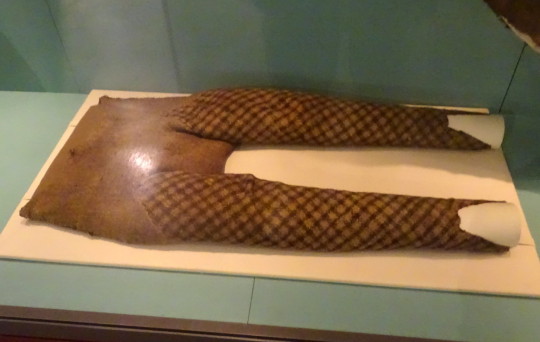
photo by hayling billy
Killery outfit with and without brat:

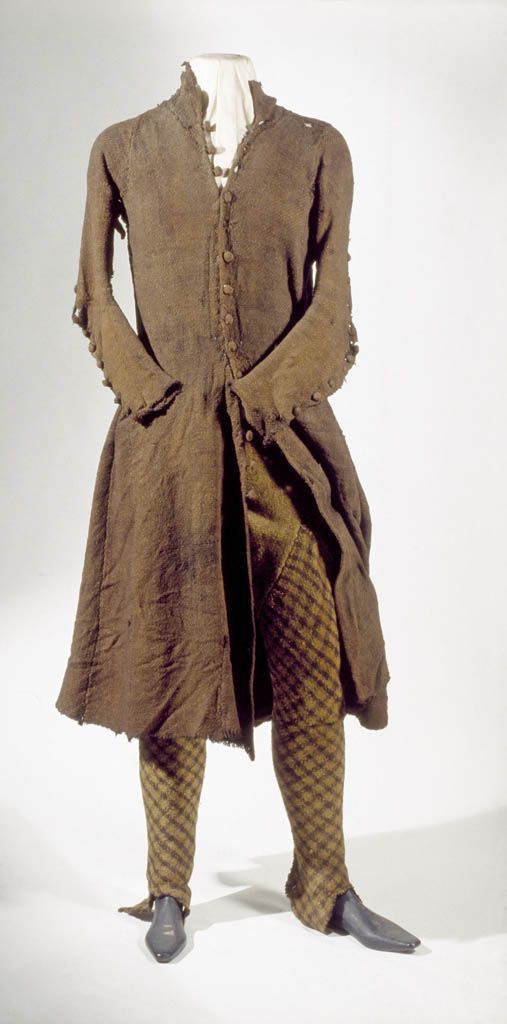
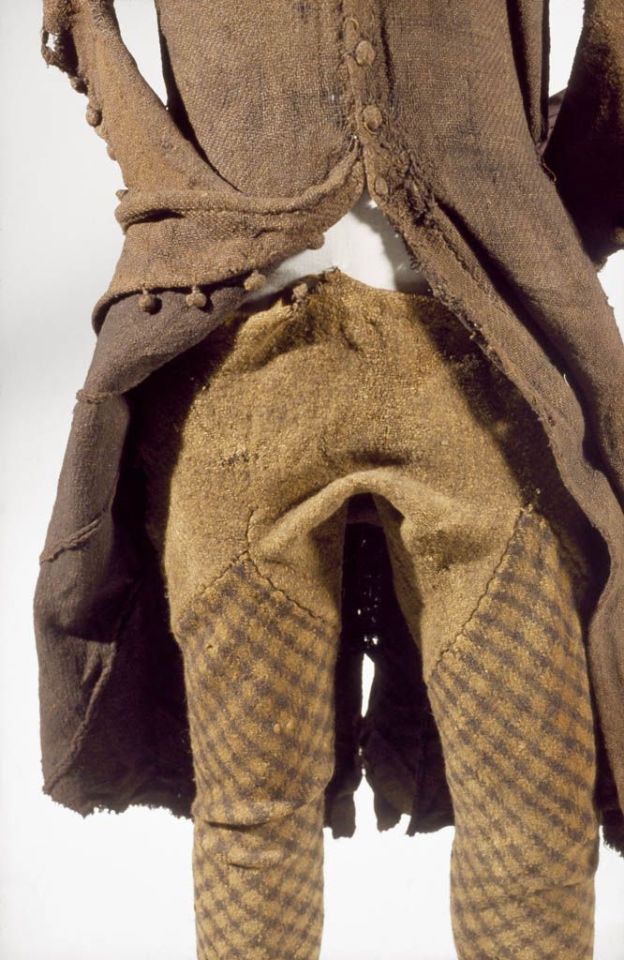
The outfit is generally dated to the 17th c. (Dunlevy 1989). It matches Luke Gernon's 1620 description of Irish men's winter apparel:
"in winter he weares a frise cote. The trowse is along stocke of frise, close to his thighes, and drawne on almost to his waste, but very scant, and the pryde of it is, to weare it so in suspence, that the beholder may still suspecte it to be falling from his arse. It is cutt with a pouche before, which is drawne together with a string."
Additional photos of the outfit: cóta front, hem, buttons, and brat.
Shinrone gown:
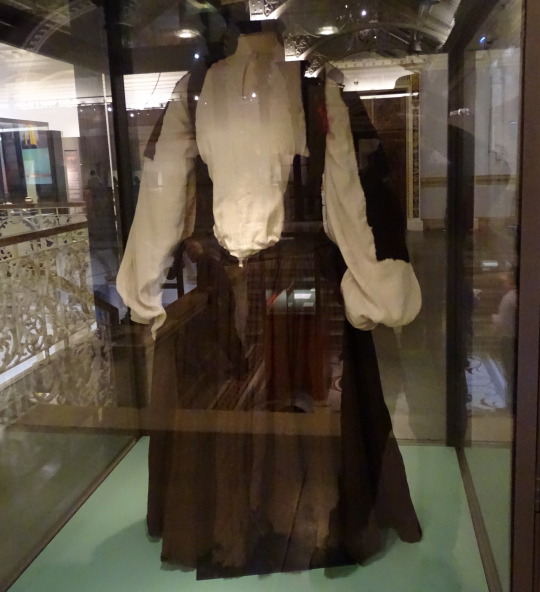
photo by hayling billy
The Shinrone gown was found in a bog in 1843 in Co. Tipperary near Shinrone, Co. Offaly. Unlike the Killery outfit, there were no human remains or other items found with it (Briggs and Turner 1986). The ends of the sleeves and possibly also the bottom of the skirt are missing. The sleeves would have had wrist cuffs or ties that allowed them to be fastened around the wearer's wrists. It probably also had loops or rings along the U-shaped center-front opening for lacing. It is typically dated late 16th-early 17th c, based on its similarity to a circa 1575 illustration by Lucas DeHeere and to the dresses described by Luke Gernon in 1620 (Dunlevy 1989, McGann 2000). It could be older however, because Laurent Vital described dresses with this type of sleeve in 1518.
Copyrighted, better quality photos: left front, right front, back Additional details: side-front, front waistline
Tipperary Cóta Mór:
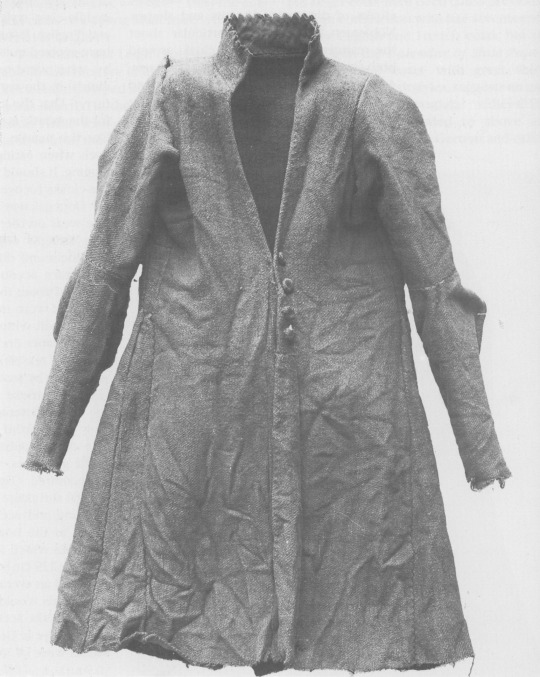

photos from Dunlevy 1989 and hayling billy
Another Cóta Mór. This one is from Co. Tipperary, exact find spot and date unknown. Like the Shinrone gown, it was not found with human remains or other items (Ó Floinn 1995). It is probably also from the 17th century (Dunlevy 1989).
Additional photos: front, side, front buttons, front detail, side
Brat and hats:

photo by hayling billy
I haven't been able to find any clear photos of the label on this display, but based on the excellent condition and the presence of the leather tie, I think this is the Meenybradden woman's brat.
Closeup of the tie:
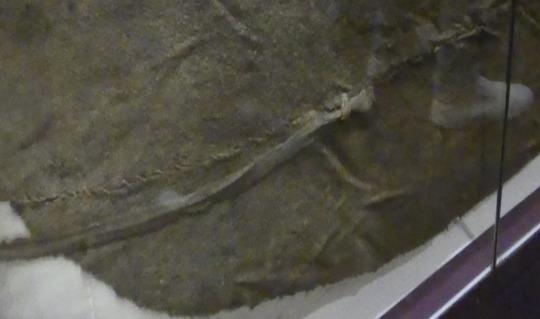
The Meenybradden woman is a bog body found in Meenybradden bog, Co. Donegal in 1978. The brat was wrapped around her as a shroud and secured with the leather tie (Delaney and Ó Floinn 1995). No other garments or artifacts were found with her, although she may have been wearing a linen garment such as a léine when she was buried. Linen tends to not survive in bogs. The Meenybradden woman has a calibrated radiocarbon date of AD 1130-1310, but some archaeologist have suggested humic contamination from the peat may be throwing off the dating. Her brat is identical in cut to others from the 16th-17th centuries (Delaney and Ó Floinn 1995).

Meenybradden brat laid flat. (photo from Delaney and Ó Floinn 1995)
Wool hats:

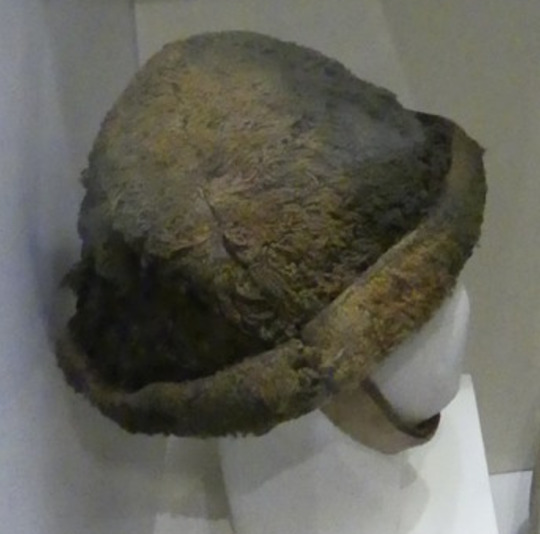
Hats from Boolabaun, Co. Tipperary made of wool felt which has been cut and sewn to form the shape. They have togs of unspun wool worked into them giving them the appearance of faux fur. Dunlevy suggests a 15th-16th c date for them (Dunlevy 1989, McClintock 1943).
Wool cloak:
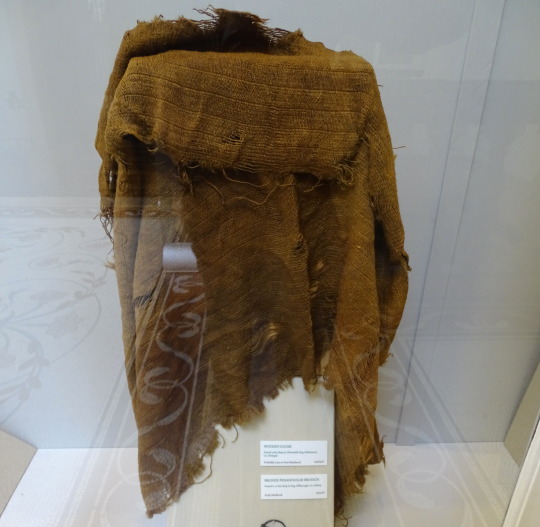
photo by hayling billy
The museum label says it's from Glenmalin bog, Malinmore, Co. Donegal, but I think this may be a mistake. According to Ó Floinn (1995), the artifact with accession number 1946:416 from Malinmore, Co. Donegal is a bale of linen. Ó Floinn's table also gives accession number 1946:416* for a group of clothing from Owenduff, Co. Mayo which includes a gown, a jacket, and a cloak. If the cloak in the photo is actually the one from Owenduff, it is probably from the 17th c (Dunlevy 1989). Alternatively, someone might have misidentified a wool cloak as a bale of linen. The museum label dates this as late Medieval to post-Medieval.
*Either Ó Floinn made a typo or this is a mistake in the museum records. Museums are not supposed to give the same accession number to 2 different artifacts. In the NMI's defense, 1946 was probably a messy year for everyone.
Bibliography:
Briggs, C. S. and Turner, R. C. (1986). Appendix: a gazetteer of bog burials from Britain and Ireland. In I. Stead, J. B. Bourke and D. Brothwell (eds) Lindow Man: the Body in the Bog (p. 181–95). British Museum Publications Ltd.
Delaney, M. and Ó Floinn, R. (1995). A Bog Body from Meenybradden Bog, County Donegal, Ireland. In R. C. Turner and R. G. Scaife (eds) Bog Bodies: New Discoveries and New Perspectives (p. 123–32). British Museum Press.
Dunlevy, Mairead (1989). Dress in Ireland. B. T. Batsford LTD, London.
Gernon, Luke (1620). A Discourse of Ireland. https://celt.ucc.ie/published/E620001/
McClintock, H. F. (1943). Old Irish and Highland Dress. Dundalgan Press, Dundalk.
McGann, K. (2000). What the Irish Wore/The Shinrone Gown — An Irish Dress from the Elizabethan Age. Reconstructing History. http://web.archive.org/web/20080217032749/http:/www.reconstructinghistory.com/irish/shinrone.html
O’Floinn, R. (1995). Recent research into Irish bog bodies. In R. C. Turner and R. G. Scaife (eds) Bog Bodies: New Discoveries and New Perspectives (p. 137–45). British Museum Press.
Vital, Laurent (1518). Archduke Ferdinand's visit to Kinsale in Ireland, an extract from Le Premier Voyage de Charles-Quint en Espagne, de 1517 à 1518. translated by Dorothy Convery and edited by me. https://irish-dress-history.tumblr.com/post/721163132699131904/laurent-vitals-1518-description-of-ireland
#16th century#17th century#irish dress#dress history#gaelic ireland#historical men's fashion#historical women's fashion#bog finds#irish history#historical dress#brog#bratanna#irish mantle#headwear#triús#cóta mór
60 notes
·
View notes
Photo
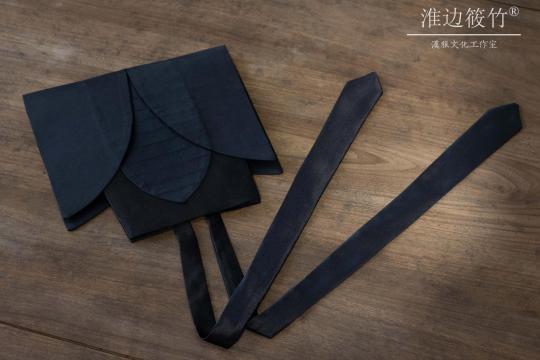


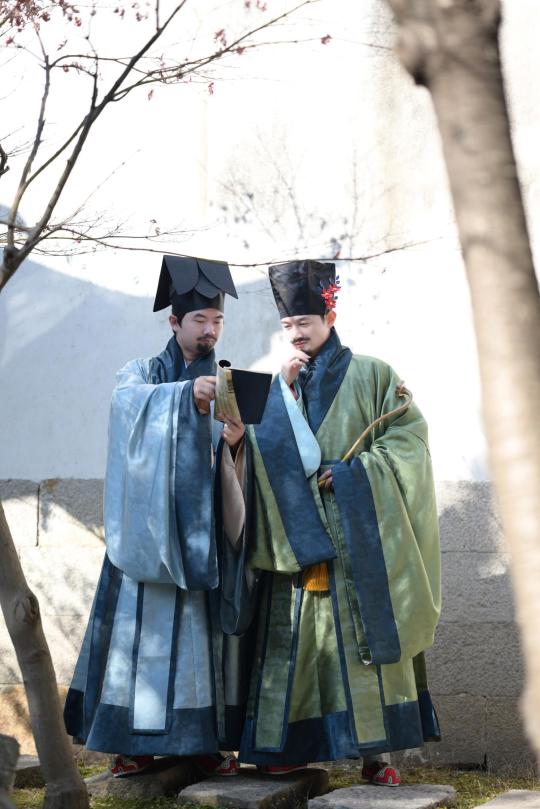
蝉腹巾 Chán fù jīn (cicada belly hat) by 淮边筱竹汉服文化工作室
In the last picture, both men were wearing 道服 (dàofú) - not to be confused with a 道袍(dàopáo) - and a pair of 云履 (yún lǚ - cloud shoes). The man on the left (in blue) was wearing the chanfujin shown above while holding a book.
The the man on the right (in green) was wearing a 四方平定巾 (sìfāng píngdìng jīn - a square hat with a flat top) with a red 花簪 (huāzān - flower hairpin). It was probably a 缠花 (chán huā - a type of handicraft made by wrapping threads on a flat surface, usually made into leaflets and those leaflets are then arranged to make flowers, leaves, insects, etc.). He was holding a 如意 (rúyì - ‘as [you] wish’ - a type of scepter).
#men's hanfu#glasses#淮边筱竹汉服文化工作室#hanfu#daofu#daopao#yunlv#shoes#jin#headwear#man's headwear#so true#sifangpingdingjin#chanfujin#簪花
77 notes
·
View notes
Text
Shiera Seastar moodboard/inspirations


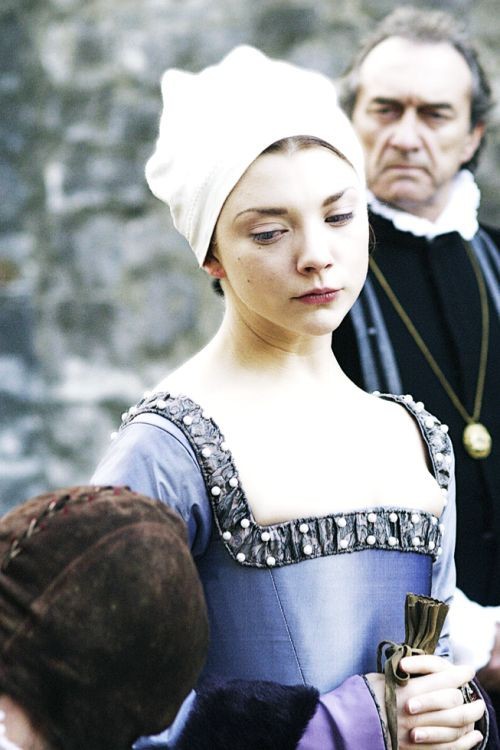



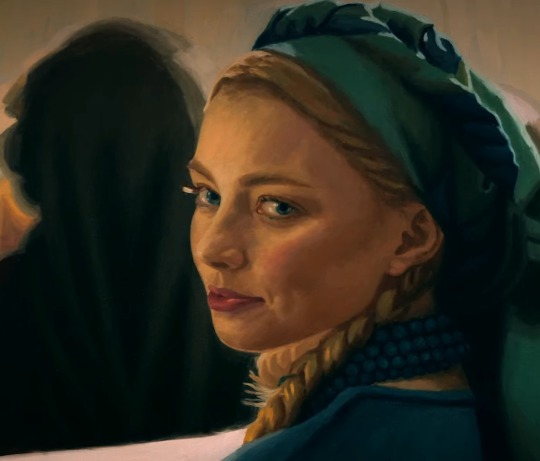

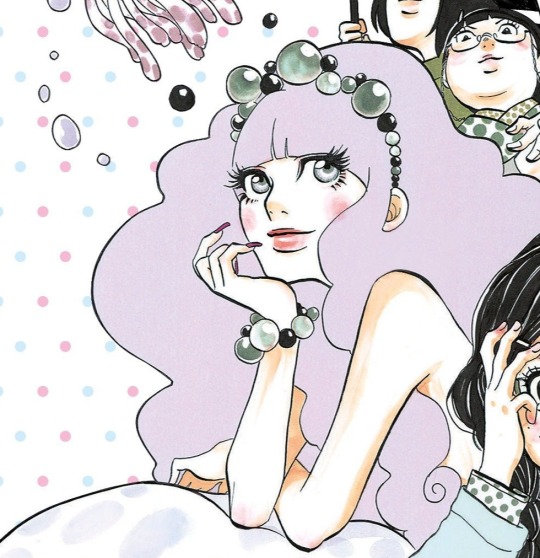

#shiera seastar#asoiaf#valyrianscrolls#house targaryen#little headcanon creeping in my head#shiera wore her hair long but liked to put it under a stylish headwear#hiding it to be more alluring#only showing it in its full glory to the men closer to her#wearing headwears dissimulating the hair inspired by queen naerys' fashion ?
22 notes
·
View notes
Text

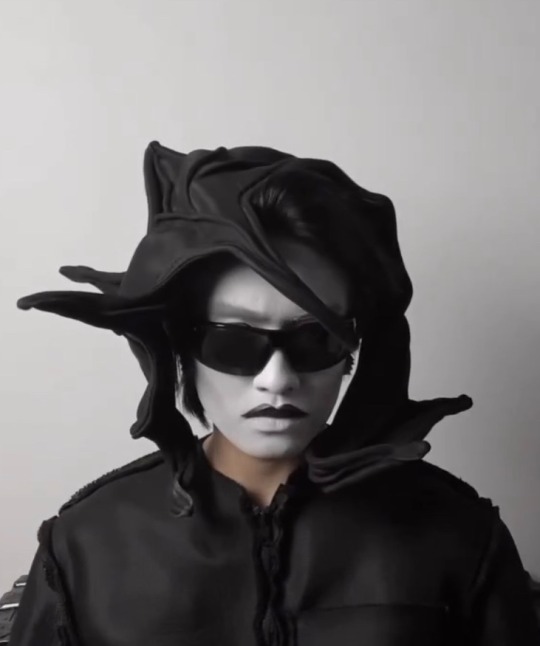
batwing headpiece, 2023
#Jean Louie Castillo#goth#goth fashion#jeanlouiecastillo#fashion designer#goth aesthetic#gothic#goth menswear#goth men#alternative goth#dark fashion#headpiece#headwear#crown#hat#hats#sombrero#fascinator#fashion#fashion design#fashion editorial#diy fashion#high fashion#couture#goth makeup#the crow#black outfit#black and white#gothgoth#gothcore
8 notes
·
View notes
Text
Get This Hat and Cap Design
Worldwide shipping

ORDER NOW
#buckethat#baseballcap#dadhat#headwear#summer#love#art#fashion#baseball#hats#travel#photooftheday#photography#streetwear#style#ootd#nyc#women#instagood#sun#snapback#men#nature#beautiful#redbubble#artists on tumblr#outfit#outfit inspiration#trends#trendingnow
3 notes
·
View notes
Text
Get our workwear prioritize safety at all times and comfort always
Throughout your workday, these high-visibility t-shirts will keep you cool and comfortable while making sure you're easily visible. Lightweight, breathable materials are used in the construction of our hi-vis tees to provide ideal airflow. You stay dry and cool with this, even on the warmest days. Breathability, however, does not curb visibility. You're visible from every direction thanks to the vivid bright colors and luminous stripes, which maximize your safety in any kind of workplace. To meet your unique demands, we at All Workwear have a large selection of hi-vis tees. For active tasks, select moisture-wicking alternatives or traditional crewnecks. We have the ideal hi-vis tee for you, regardless of your industry. With the range of shapes and colours available you can infuse your workwear with a little flair. Choose a t-shirt that matches your company's branding or personal style, ranging from vibrant orange to traditional high-vis yellow.
#cooling pants womens#womens cooling pants#jbs t shirts#waterproof freezer gloves#men's cooling cargo pants#cooling cargo pants#aussie hoodies#layered shirt womens#womens layered shirt#portwest work pants#aussie pacific singlets#biz corporates tops#Biz Corporate#DNC Workwear#cotton safety vest#aussie pacific workwear#jb's wear work pants#Biz Care workwear#biz care apparel#biz corporates shirts#headwear beanies#dnc work pants#king gee work pants#dnc hoodie#Aussie Pacific#biz care scrub pants#dnc work shirts#jb's wear work shirts#dnc clothing#workwear australia
0 notes
Text

Top-Quality Men's Headwear: Your Ultimate Style Upgrade at Bash, South Africa!
0 notes
Text

Hi, thanks for the question, and sorry for taking ages to reply!
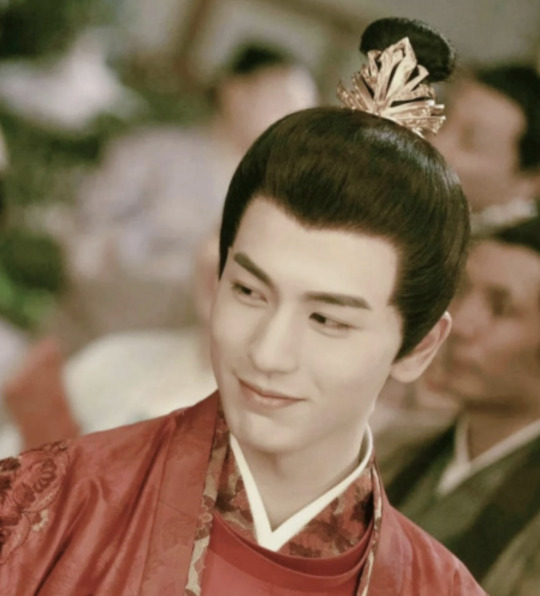
The crowns/hairpieces men wear to secure the buns on the top of their heads are called guan/冠. There’s a Wikipedia article on guan here. The smaller ones that cover just the bun are called xiaoguan/小冠 (small guan).
I wrote about guan and xiaoguan in my posts here: 1, 2, 3, 4, and I also have a xiaoguan tag here. Please check them out!
Hope this helps!
(Image is from cdrama Love Between Fairy and Devil)
#oops accidentally deleted the original ask so I had to copy & paste#mens headwear#guan#xiaoguan#hanfu#mens hanfu#>100#ask#reply#reference#chinese fashion#china
208 notes
·
View notes
Text
How to Choose the Perfect Trucker Hat for Your Personality
Discover how to pick the ideal trucker hat for your style! Find the perfect match that complements your personality and boosts your look. Read more!
0 notes
Text
Identifying J.C. Walker's Illustrations
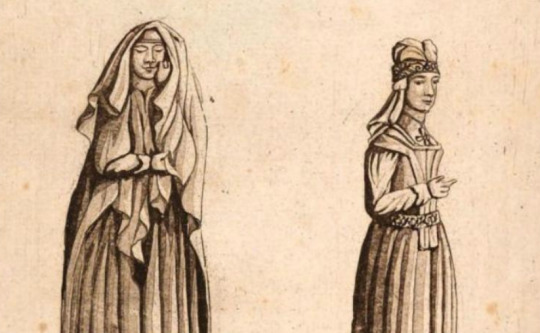
An Historical Essay on the Dress of the Ancient and Modern Irish by Joseph Cooper Walker published in 1788 was the first major work published on Irish dress history. Due to a combination of the limited information known at the time, and his erroneous assumption that Irish dress didn't change for the entirety of the Middle ages, Walker got a lot of things wrong, so his writing isn't cited much anymore. Some of his illustrations, however, are still used.
Because Walker lived before the invention of photography, he used drawings of historical Irish art created by colleagues and family to illustrate his book. I decided to track down the original works of art to see how Walker's drawings compared. I am resorting these into roughly chronological order, because Walker's lack of regard for chronology makes my head hurt.
The High Crosses, 9-10th centuries:
Ireland's high crosses have unfortunately lost a lot of their detail due to erosion, making these hard to identify. Sadly, the breeches with a fitted knee-band and the skirt gathered to a waistband look more Late Medieval or Early Modern than they do Early Medieval, so I don't think these are reliable depictions of the lost detail.
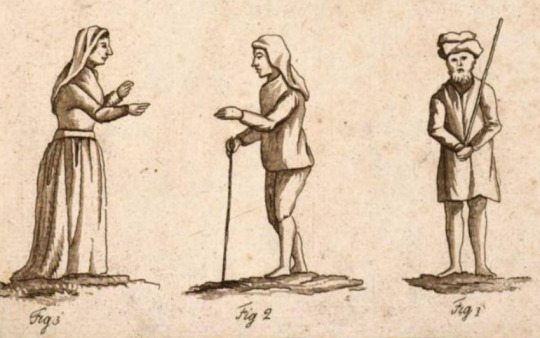
Plate 1: Figure 1 (right) is supposed to be from the Clonmacnoise Cross of Scripture. At a guess, it's based off the guard on the right arresting Jesus:
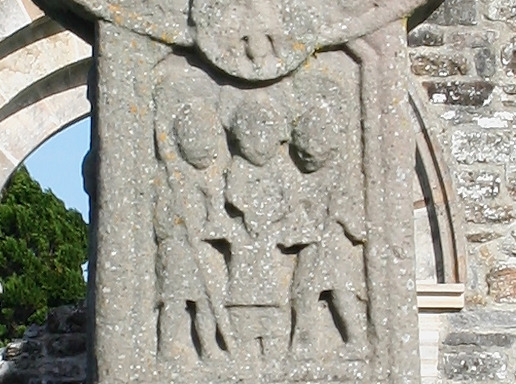
Figures 2 and 3 are based off a high cross fragment at Old Kilcullen, County Kildare. Unfortunately, I don't think the original carving survived. I initially blamed its loss on the United Irishmen, but this drawing from 1889 convinced me that acid rain was the real culprit.
Plate 5 Figure 1 is supposed to be a king from Muiredach's cross. The closest image I could find on the actual cross is Cain killing Able:

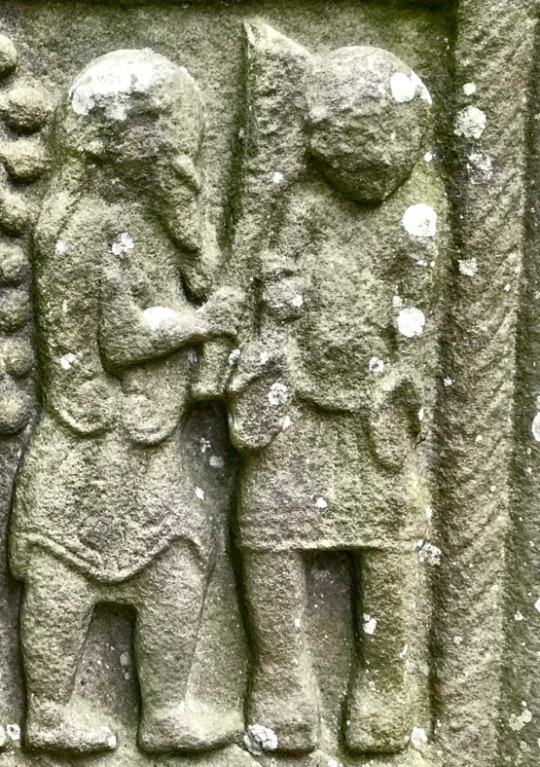
Ironically, Cain and Able have more embellishment on their clothes than the "king" based off of them.
12th century:
Plate 1 Figure 5 is from the capital of an arch at St. Saviour's Priory in Glendalough, County Wicklow. The drawing gives the impression that the sides of the head were shaved and the hair was deliberately curled at the end. In the actual carving, the hair is slicked back at the sides and interlaced with adjacent design elements. These are stylistic elements of Irish Romanesque art and not intended to be a realistic depiction of an Irish hairstyle.
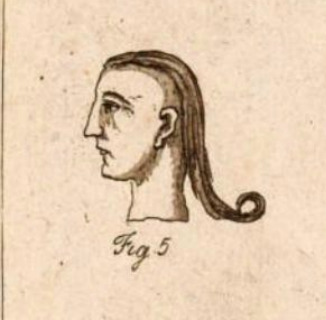

13th century:
Plate 4 is the late 13th century effigy of Felim O'Connor, Dominican Priory of St. Mary, Roscommon with a frontal of gallowglasses added in the 15th c.

This drawing is pretty accurate, although the gallowglasses are lacking some details like their quilted cloth gambesons.

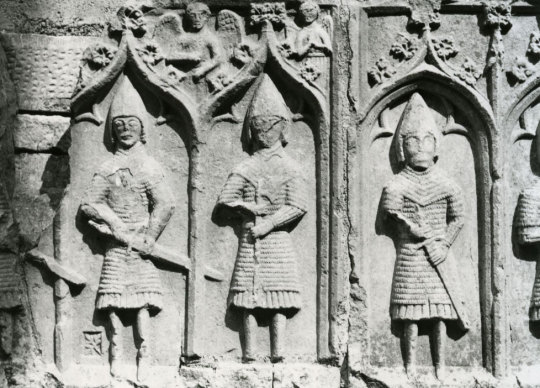
photos by Edwin Rae
I cannot find a good photo of Felim O'Connor's effigy, but Conor O'Brien's contemporary effigy at Corcomroe Abbey, County Clare wears the same style of clothing.
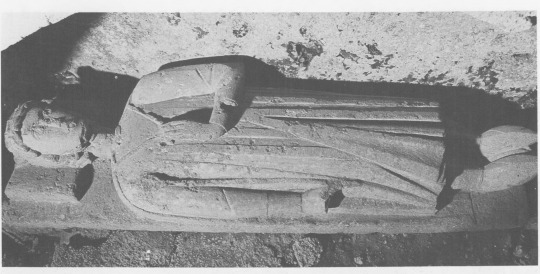
13-14th century?
Plate 6 is based on a sculpture from Athassel Priory in County Tipperary. I can't find a solid date for this one. Athassel Priory was built c1200 and then burnt and rebuilt twice before it was dissolved in 1541. The clothing style of the carving makes me think it's from the earlier part of this time frame.
The biggest thing the drawing gets wrong is the gender. This is a man, not a woman. The "necklace pendent" on his chest might have actually been a brooch holding his cloak, but the sculpture is now too damaged to tell. The drape of fabric at his side, which Walker calls a train, is actually the edge of his cloak. The drawing also leaves out the way his become more fitted below the elbow.
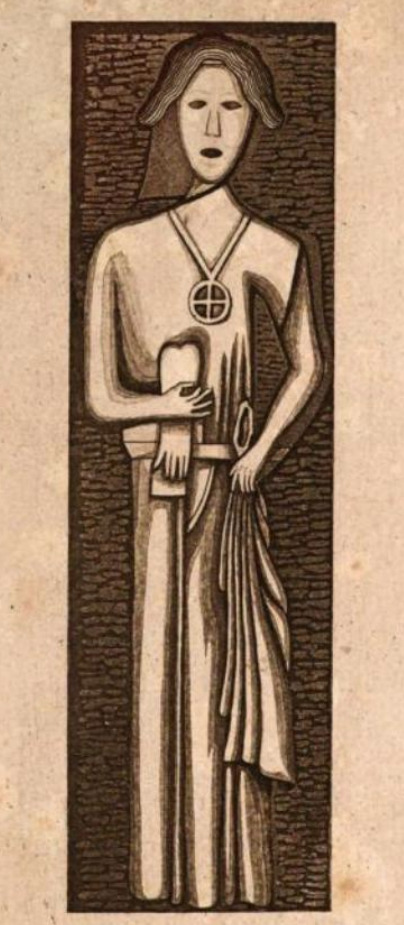

15th century:
Plate 3 Figures 1-3 are based off a painting at Knockmoy Abbey.

I'm pretty sure those are houppelandes on the left and center figures. This continental fashion influence shows up elsewhere in 15th c. Ireland (Dunlevy 1989). The drawing omits the massive houppelande sleeves and shortens their hems.

The painting is now badly weather and difficult to see. This is a more accurate drawing published in 1904. Recent photograph here
Plate 5 figure 2 and plate 1 figure 6 come from a 15th c. grave at the Dominican Friary, in Strade, County Mayo.
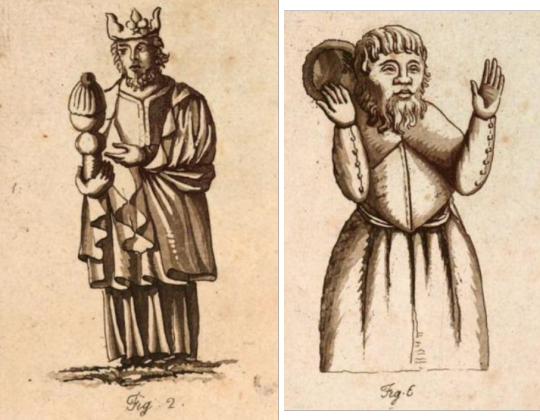
Figure 2 is a decent representation, although it adds a center front slit to the leine which I don't think is actually there. Figure 6 gets the silhouette of the cotehardie a bit wrong and omits the hanging belt accessories, but its greatest crime is that it makes the top of the hood look like a separate object. Walker actually misidenifies it as a Scotch bonnet.
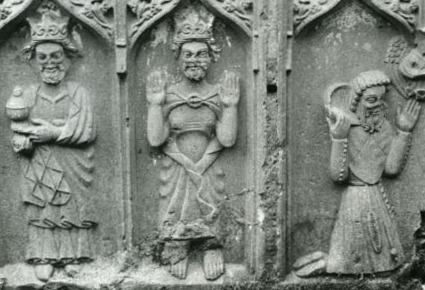
photo again by Edwin Rae
Plate 7 is Anne Plunket's effigy at St. Mary's Church, Howth, County Dublin. This drawing is decent, though the sleeves are a bit too slim. The cross necklace and belt decorations are no longer visible on the effigy.
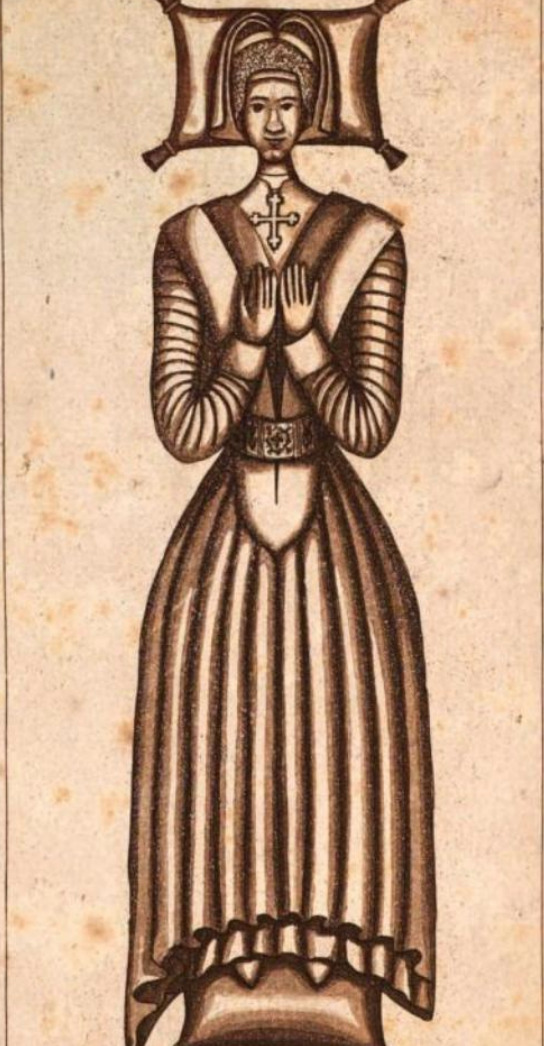
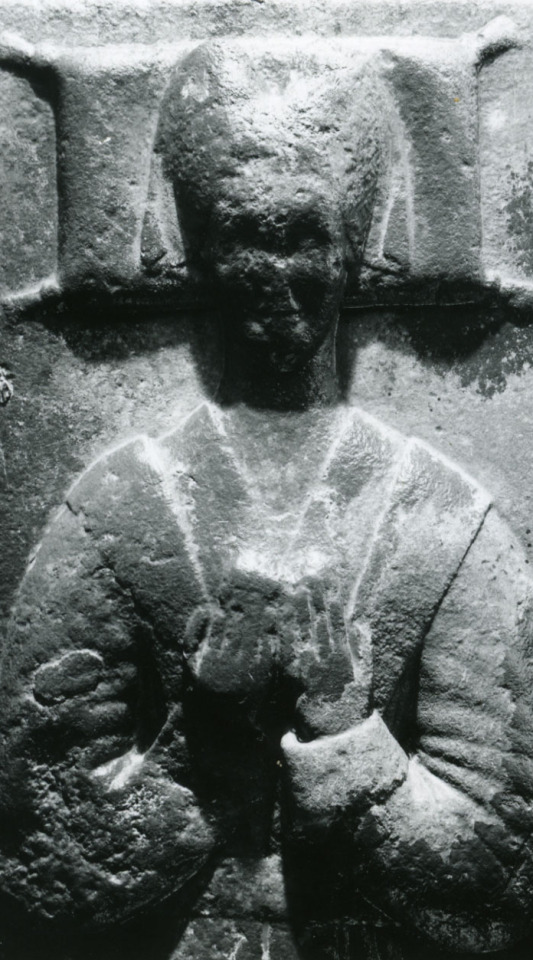
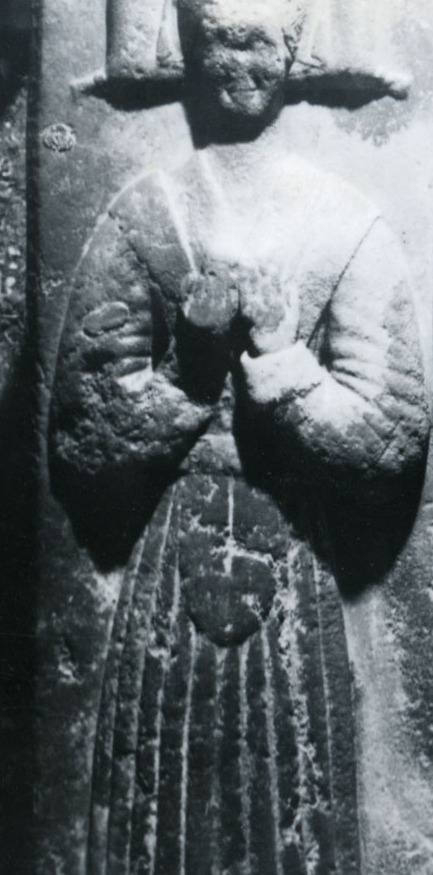
photos by MVP Edwin Rae
Plate 8 figures 1 and 2 are both based on a late 15th c. tomb at the New Abbey in Kilcullen, County Kildare. Figure 1 is based off a carving which is probably depicting St. Brigid, which makes her headwear the wimple of an abbess, not a laywoman's kerchief Walker. The drawing, however, omits her telltale crozier. The drawing makes it look like she has cuffed sleeves, but that is actually just the folds of her brat draped over her arm. It also shows her as wearing 2 layers of skirts when she is actually wearing a single lower garment with a hem circumference so large that it puddles at her feet.
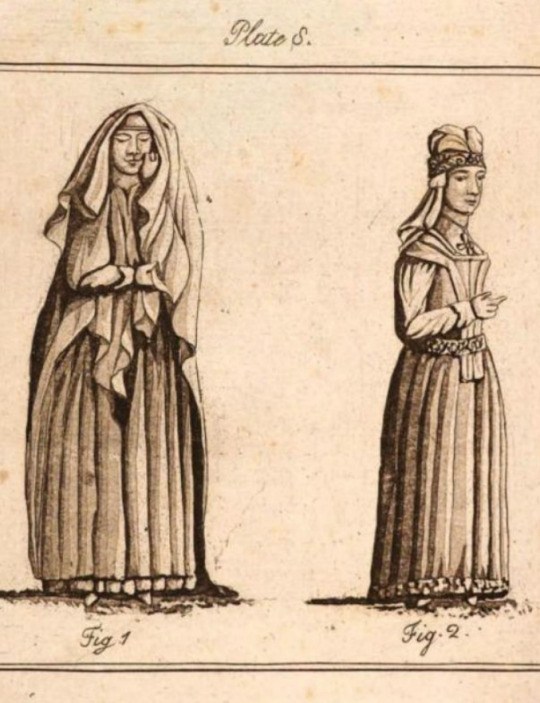

Figure 2 is based of Margaret Janico's effigy. The effigy is now too badly eroded to make out details, but it originally probably looked very similar to Margaret Janico's other effigy in St. Audoen's Church, Dublin. Unlike Anne Plunket's effigy above, the necklace and belt decorations are still faintly visible on the Dublin effigy. Figure 2 distorts the construction of the gown and headwear. This drawing makes the bodice of the gown look heavily stiffened or even boned like 17th c. stays. The houppelande on the effigy does not have stiffening in it.
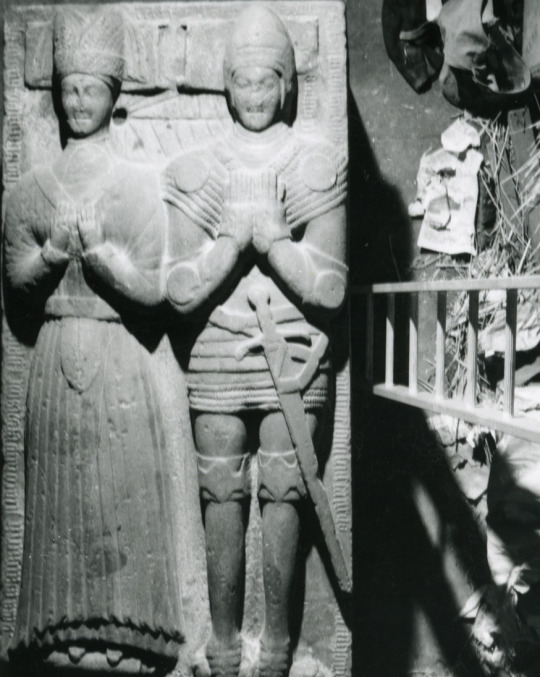
effigy of Margaret Janico and husband at St. Audoen's Church, Dublin (photos, once again, by my man Edwin)
The headpiece in the drawing looks like a linen kerchief wound up to form a turban with a decorated fillet tied over it. The headpiece on the effigy is probably actually a truncated hennin with a veil pinned to it like the one in this mid-15th c Burgundian painting by Petrus Christus.
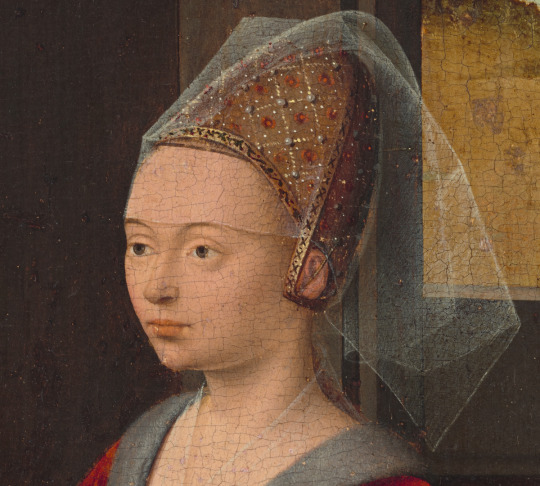
16th century:
Plate 9 is based on Katherine Molloy's early 16th c. effigy at Fertagh Church, in County Kilkenny. According to the artist's notes it was in "nearly perfect" condition at the time. I wish he had put more detail into the drawing.

(photo also by Edwin Rae)
17th century:
Plate 10 is based on The Taking of the Earl of Ormond in anno 1600. Walker's artist clearly fabricated some detail here, falsely giving the impression that triús were ankle-length. We know from extant examples from Kilcommon, Dungiven, and Killery that triús actually extended past the ankle, covering part of the wearer's foot (Dunlevy 1989, Henshall et al 1961).
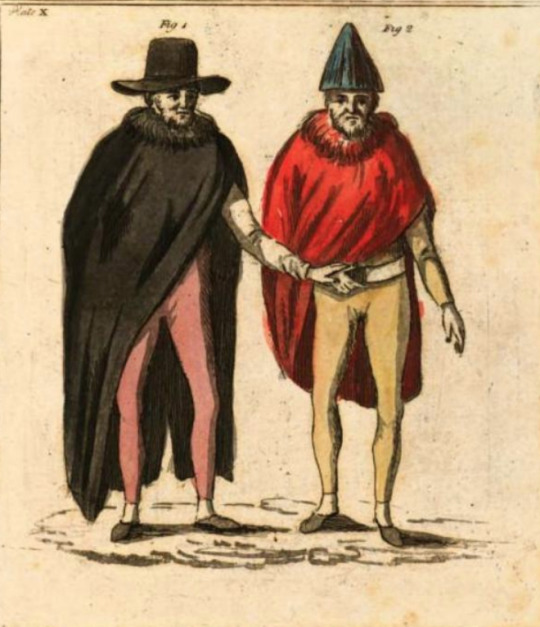

Plate 11 was taken from the tomb of Sir Gerald Aylmer (died 1634) and Juliana Nugent. Sadly, it appears to have been destroyed in the early 19th c, so I have no further pictures of it. The clothing looks to me like typical 1630s English fashion with loose gowns over doublets, falling bands, and linen cuffs.
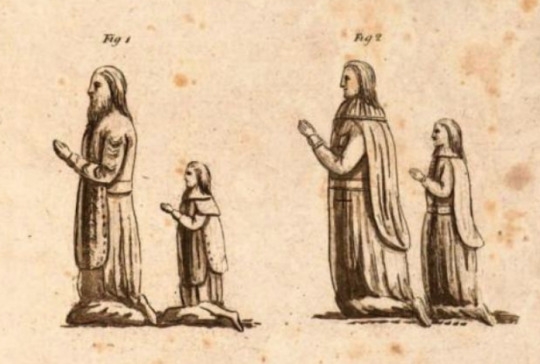
? Century
Plate 1 figure 4 is apparently from Old Kilcullen, County Kildare. I am not sure what this is based on. I haven't seen any Santa hats at Old Kilcullen. Or anywhere else in Medieval Ireland.
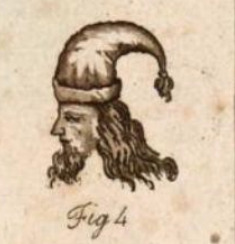
Bibliography:
Dunlevy, Mairead (1989). Dress in Ireland. B. T. Batsford LTD, London.
Henshall, Audrey, Seaby, Wilfred A., Lucas, A. T., Smith, A. G., and Connor, A. (1961). The Dungiven Costume. Ulster Journal of Archaeology, 24/25, 119-142. https://www.jstor.org/stable/20627382
Edwin Rae's invaluable collection of photographs of Late Medieval Irish art accessed via TARA.
#15th century#irish dress#dress history#irish history#art#early medieval#16th century#historical women's fashion#historical men's fashion#historical fashion#hiberno norman#gaelic ireland#headwear
11 notes
·
View notes
Text
Headwear Accessories: Top Off Your Look with Flair
Complete your outfit and protect yourself from the elements with our stylish headwear accessories. Our collection features a wide range of headgear options for every season and occasion. From classic caps and hats to cozy beanies and sleek fedoras, we offer headwear that combines fashion and functionality. Whether you're shielding yourself from the sun's rays, staying warm during winter, or simply making a fashion statement, our headwear accessories have got you covered. Explore our versatile selection and find the perfect headwear to add that finishing touch to your ensemble. It's time to elevate your style, protect yourself from the elements, and express your unique personality with our top-notch headwear options.

#headwear accessories#men's accessories#travel accessories for men#men's bottomwear#trendy mens boots#mens designer shoes#casual shirts for men#men's apparel online
1 note
·
View note
Photo


daopao (green) + dahu (white) + fujin (head) by 衿娥传统服饰
93 notes
·
View notes
Text
Best new arrivals products usa,Loudtrax -Is The Best Company in Canada,
Best new arrivals products usa, Loudtrax -Is The Best Company in Canada,
Based on the search query "new dresses UK," here are some options for new arrivals:
Loudtrax-Next UK offers a range of new dresses for women, including options like the Myleene Klass Floral Embroidered Wrap Dress, V&A l Love & Roses Ivory Floral Printed Halter Pleated Midi Summer Dress, and Lipsy Gold Premium Placed Sequin Knot Bust Maxi Dress
Roman UK offers a collection of new dresses for women, ranging from figure-flattering trendy styles to occasion-ready pieces and cozy casuals
Coast presents a range of new dresses, including options such as the Loved By Lisa Embellished Mixed Sequin Maxi Dress and Georgette Jacquard Frill Midi Dress
lovers of style turn to Loudtrax,
The rise of fashionable Loudtrax -Is The Best Company in Canada, influencers and stylists paved the way for the bloggers on our list to have a significant presence online. Many of these bloggers started out on social media, and their keen eye for style did not go unnoticed by their followers. While they have their own website, most of them continue to be active on Instagram and YouTube.
Best new arrivals products USA, And new arrivals dresses uk, Loudtrax -Is The Best Company in Canada,
For more information visit us - at www.loudtrax.com
#new arrivals products usa#new arrivals dresses uk#men wear online usa#men wear online canada#mens wear online uk#women wear near me#women wear online usa#women wear buy online canada#headwear for men usa
0 notes
Photo

Rainbow Knitted Beanie Hat | Black
Looking for a stylish and comfortable headwear option? Check out our Rainbow Knitted Beanie Hat made from soft Peruvian Chullo material. This hat is not only perfect for snowboarding, but also makes a great chemo headwear option. Plus, it comes in a beautiful emerald color that will add a pop of color to any outfit.
- Hand-knitted alpaca beanie hat
- Warm, soft, and comfortable
- Colorful unisex cap
- Made of alpaca
Measurements:
Head circumference: stretches from 18 inches (46cm) to 20 inches (51cm)
Length from top to bottom: 9 inches / 23cm
Care Instructions:
- Gently Hand wash
- Do not wring
- Lay flat to dry
- Do not tumble dry
https://www.etsy.com/listing/1483037476/rainbow-knitted-beanie-hat-soft-chemo
#boho hat#beanie hat#womens wool hat#colorful hat#knitted hat#cap#winter warm hat#chemo headwear#cancer hat#head cover#alopecia#slouchy beanie#mens beanie
0 notes